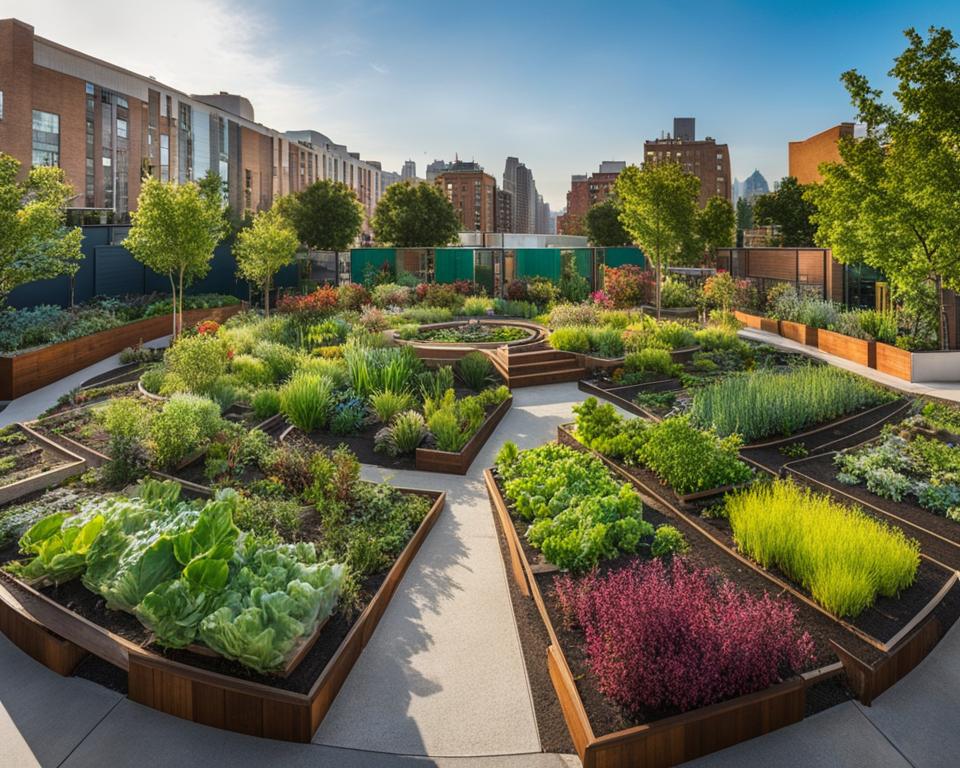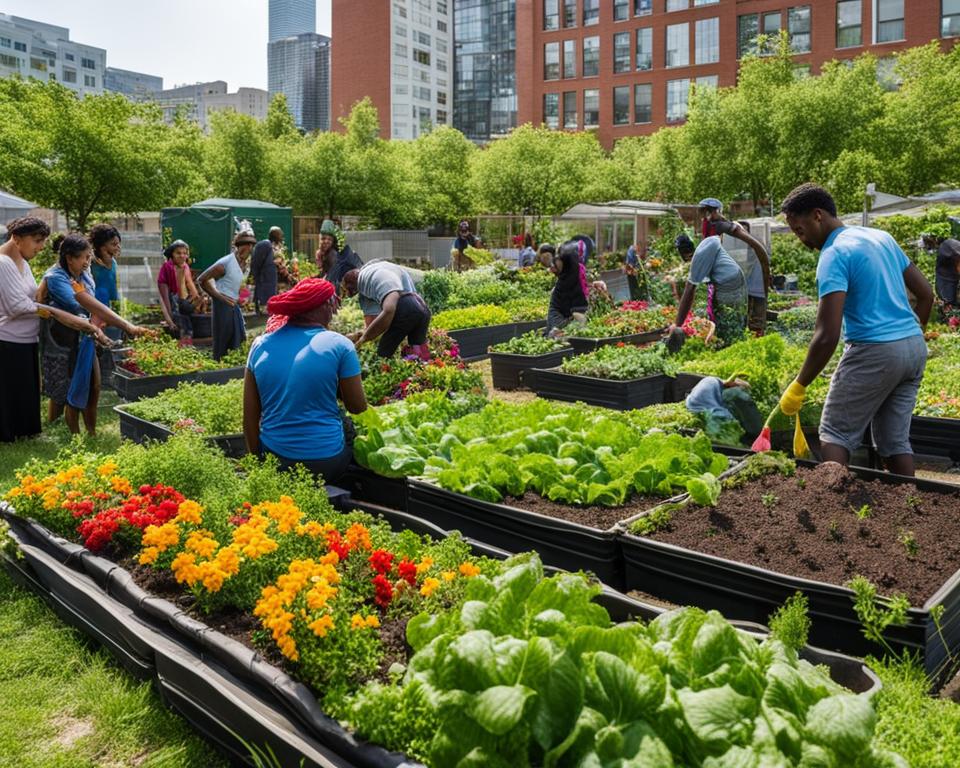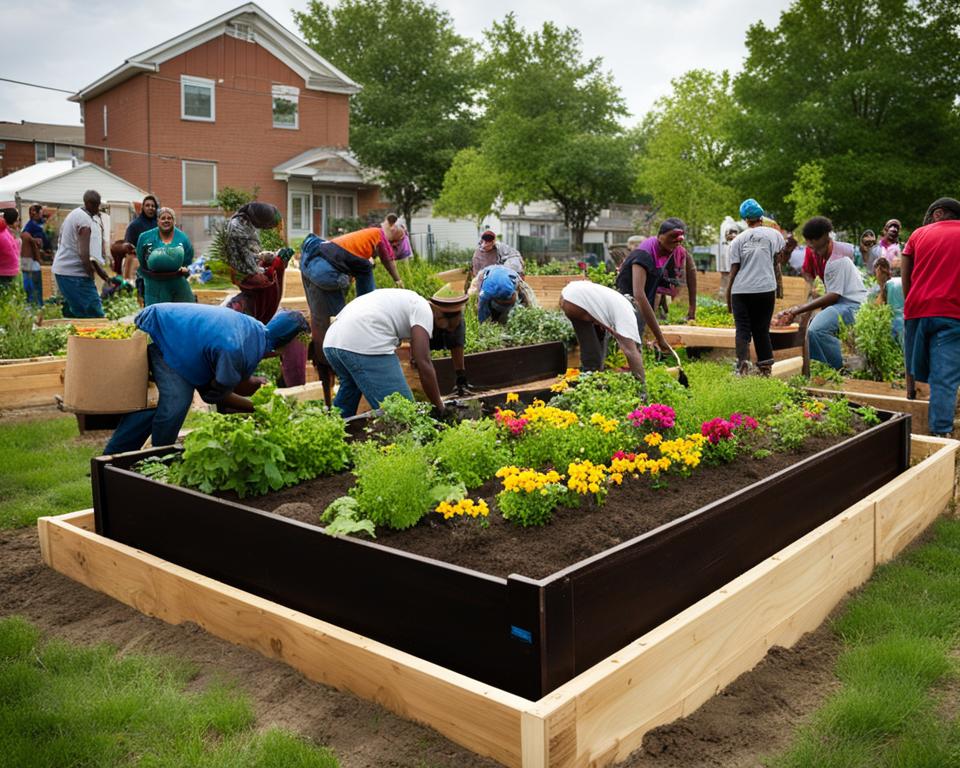Are you passionate about creating vibrant green spaces within your urban environment? With urban gardening grants, you have the opportunity to transform concrete jungles into lush oases. Whether you’re part of a nonprofit aiming to bolster your community’s well-being or an individual striving for ecological stewardship, funding for urban garden projects is within your reach. These financial supports are designed to fuel initiatives that not only beautify cityscapes but also promote sustainability and social cohesion through community gardening grants.
Imagine the possibilities when you tap into resources crafted to empower green thumbs and community hearts alike. Securing grants for sustainable gardening projects can be a game-changer, offering more than just monetary assistance—it’s a chance to sow the seeds of change and nurture growth where it’s most needed.
Key Takeaways
- Discover potential grants to jumpstart or enhance your urban gardening endeavors.
- Learn how these grants can foster community connections and promote well-being.
- Explore various grant opportunities with flexible deadlines and diverse funding amounts.
- Understand the impact of gardening projects on children’s health and community equity.
- Prepare to leverage funding avenues focused on sustainability and social benefits.
The Benefits of Urban Gardening and Community Well-being
As you explore the world of urban agriculture, you’ll find that beyond providing fresh produce, these green spaces wield a transformative power for communities and families. It’s not just about grants for urban agriculture or securing urban garden funding; it’s about nurturing health and well-being at every level of society. Let’s delve into how community gardens are creating positive change, one seed at a time.
Addressing Child Well-being Through Gardening
The Child Well-being Program has made a poignant connection between thriving children and the greenspaces they have access to. With grants for community gardens, organizations are planting more than seeds – they’re sowing opportunities for kids to grow in a positive and nurturing environment. These gardens combat systemic inequities, offering a place of learning and growth that caters not just to the body, but to the mind and spirit as well.
Impact of Green Spaces on Neighborhood Health
Community gardens do more than beautify empty lots; they serve as hubs of social interaction and physical activity, essential for neighborhood-level efforts aimed at enhancing the communal quality of life. Funded programs emphasize creating inclusive social spaces, promoting health, and forging stronger community bonds. These initiatives showcase the reciprocal relationship between health and well-being and the presence of urban green spaces.
Intergenerational Influence of Community Gardens
Intergenerational work in community gardens strengthens familial ties, connecting children with elders in a tapestry of shared experiences. Grants for urban agriculture often focus on these dynamic ecological spaces that serve as classrooms for life lessons across generations, fostering continuity and a sense of belonging that extends beyond the immediate family to encompass the broader community.
| Grant Focus Area | Community Impact | Intergenerational Benefits |
|---|---|---|
| Child Development | Safe play spaces | Youth mentorship by seniors |
| Social Services | Access to fresh food | Shared gardening responsibilities |
| Neighborhood Health | Cultural programs | Storytelling and history sharing |
| Familial Well-being | Stress reduction | Nurturing family cohesion |
By recognizing the profound influence community gardens have on personal growth and neighborhood vitality, we can appreciate the vital role played by grants for urban agriculture. They are the vital nourishment for these havens of green, where children, families, and communities flourish together.
Finding Funding: An Overview of Urban Gardening Grants

As you dig into the world of urban greening and revitalization, you’ll find that urban farming grants, grants for urban agriculture, and community gardening grants are pivotal for planting the seeds of change in your neighborhood. These grants serve as a financial lifeline for initiatives that aim to convert concrete jungles into lush, verdant spaces.
Navigating the landscape of grant opportunities might seem daunting, but with resources like Instrumentl, you can streamline the process. Whether you’re looking to sprout a new garden project or nurture and expand an existing one, grants are available to support your organization’s mission and the community-focused projects you envision.
- Start-Up Funds: For those new to urban agriculture, look for grants that specifically fund start-up operations. These are designed to help you break ground and get your garden off to a healthy start.
- Operational Growth: Ready to branch out? Expand your urban agriculture endeavors with grants focused on scaling existing operations.
- Facility Improvements: If your community garden is established but could use a makeover or enhanced facilities, target grants that provide resources for improvements.
Keep a watchful eye on rolling deadlines, as they vary across different grant providers. Timing is crucial when it comes to securing funding, so be sure to track these dates closely.
Remember, the right grant can serve as the catalyst for your urban agriculture project, transforming a mere concept into a blooming reality for the entire community to enjoy.
Exploring Grant Avenues: Government, Nonprofit, and Corporate Sources

As you delve into the world of urban gardening, it’s crucial to recognize the diverse funding opportunities available that can transform your green dreams into reality. Government agencies, nonprofit organizations, and corporations offer an array of grants tailored to support community development through urban gardening initiatives.
Government Grants for Urban Gardening
Government grants for urban gardening are a cornerstone in promoting sustainable community facility development, particularly within rural areas. These grants often pave the way for the establishment of crucial community cornerstones such as local food systems and educational services. Notably, such funding isn’t solely about providing monetary support; it’s an investment in enhancing the quality of life in rural communities.
Nonprofit Grants for Urban Gardens
Turning to nonprofit organizations, you’ll find a commitment to nurturing culturally relevant programs that go beyond merely planting seeds. Nonprofit grants for urban gardens are designed to weave together the social fabric of neighborhoods, offering support to child and family services that promote the overall well-being of the community.
Corporate Funding for Green Initiatives
Fueling the green movement, corporate funding for green initiatives stands as a testament to the private sector’s role in environmental stewardship. Corporations bring to the table not only financial resources but also a spirit of innovation and commitment to corporate social responsibility that extends to community development projects.
As you consider these avenues, remember that each source of funding typically has its set of guidelines and criteria. It’s essential to align your urban gardening project with the funder’s mission and demonstrate how your initiative will create a meaningful, lasting impact in your community.
Urban Gardening Grants: Steps to Apply and Secure Funding

As someone passionate about urban gardening, you might be aware of the numerous benefits it brings to communities. Now, let’s turn that green thumb towards securing urban gardening funds. The grant application process can seem daunting, but with a structured approach, you can increase your odds of receiving that much-needed funding for urban garden projects. Here’s how to get started.
- Research Potential Grants: Identify organizations and institutions that offer grants matching your project’s mission and objectives. Look out for local government programs, nonprofits, and private foundations that have a history of supporting urban green initiatives.
- Understand the Requirements: Every grant has specific criteria. Make sure your project meets these requirements in terms of its scope, community impact, and sustainability goals.
- Prepare a Compelling Proposal: Your proposal should highlight your project’s unique value, its expected impact, and how it addresses community needs. Remember to articulate the Environmental, Educational, and Community benefits.
- Secure Letters of Support: Strong endorsements from community leaders, local businesses, and other stakeholders can significantly bolster your application.
- Review Deadlines and Submission Details: Keep track of submission dates and ensure your application is complete and meets all formatting and documentation requirements.
- Follow Up: After submission, don’t hesitate to reach out to the funding organization for updates and to demonstrate your ongoing commitment to the project.
Don’t forget to utilize online platforms that offer services to match your project with ideal grants. These resources can save you valuable time and provide insights you might not find elsewhere.
Imagine the abundant greenery and vibrant community spaces you can create with the right support. The grant application process for urban gardening is your path to transforming concrete jungles into lush, life-enhancing sanctuaries. So roll up your sleeves, and let’s dig into the details of securing your project’s future.
Success Stories: Urban Gardening Projects Funded by Grants

Discover the vibrant stories behind urban green spaces, and see how grants for sustainable gardening projects are sowing seeds of change in communities across the nation. These narratives aren’t just about gardens; they are tales of transformation and hope, deeply rooted in the belief that green spaces have the power to uplift urban landscapes and the lives within them.
Case Study: Child Well-being and Urban Gardens
Imagine a place where children learn about nature’s cycles, healthy eating, and responsible stewardship. Thanks to community gardening grants, such spaces are becoming a reality, with profound effects on child development. Case studies highlight the increase in outdoor activity, understanding of nutrition, and improved social skills, showcasing the multifaceted benefits of integrating sustainable gardens into educational curricula.
Spotlight on Community Engagement and Garden Success
Active local engagement is the root of any garden project success. Explore how urban communities, buoyed by grants, come together to cultivate not only plants but also strong, interconnected relationships. These success stories reflect the power of collaboration, demonstrating how shared green spaces can become hubs of social cohesion and collective empowerment.
Profiles in Urban Agriculture: From Funding to Flourishing
Step into the world of profiles in urban agriculture, where initial funding leads to thriving, sustainable urban projects. Trace the journey of urban farmers from the moment of receiving an urban farming grant to the day they celebrate their first bountiful harvest. These profiles not only highlight the importance of such initiatives but also serve as a compass for others seeking to nurture similar growth in their own cities.
As these stories unfold, they unveil the remarkable capacity of green spaces to foster resilience, sustainability, and a reimagined urban experience. If you’re inspired to initiate or support sustainable gardening endeavours, let these success stories guide your path and remind you of the transformative potential that lies in both the soil and the spirit of community.
How to Create a Compelling Proposal for Urban Gardening Grants
When you’re looking to secure funding for your urban agriculture initiatives, crafting a compelling grant proposal is a skill that can set your project apart. A successful proposal explains the transformative potential of your urban garden, detailing the breadth of its impact from enhancing child health to reinforcing family stability.
Remember, reviewers often have numerous proposals to consider; yours needs to vividly convey why your project deserves to be funded over others. It’s not just about the garden itself—it’s about the roots it will establish within the community.
To truly capture the essence of your project and its potential benefits, your proposal should have a narrative that resonates with the grant institution’s mission. Combining narrative flair with factual accuracy lays a foundation for a proposal that can captivate and convince.
Highlighting your organization’s capacity for managing the grant effectively, the sustainability of the project, and its ability to scale are also crucial components. Let’s delve into what makes a powerful grant proposal for securing urban gardening grants.
- Outline the objectives of your urban gardening project and how it will serve the community.
- Quantify the impact: Provide data or estimates on the number of individuals that will benefit, the amount of green space added, or the volume of produce to be harvested.
- Showcase past successes or pilot projects to support your proposal’s feasibility.
- Discuss partnerships with local organizations or businesses and how these collaborations will contribute to the project’s success.
- Detail the management plan: Include information on the team, timelines, and budget requirements to convey capable stewardship.
- Explore the potential for educational programming or community events that could be held in the space.
Your ability to create a compelling grant proposal is amplified when you understand what grant organizations are looking for. Considering these factors elevates your proposal, making it more than a request for funds—it becomes a vision for community enrichment and resilience.
| Project Component | Description | Benefit to Community |
|---|---|---|
| Community Involvement | Active participation from local residents in garden activities. | Increases social coherence and provides a sense of ownership. |
| Health Impact | Access to fresh produce and green space for recreation. | Supports physical and mental well-being across age groups. |
| Environmental Education | Workshops and events focused on sustainable practices. | Builds awareness and skills for lifelong environmental stewardship. |
| Economic Development | Job creation and sales of locally grown food. | Stimulates local economy and can reduce food deserts. |
Never underestimate the power of a thoroughly researched, passionately articulated, and finely tuned grant proposal. Your commitment to securing funding for grants for urban agriculture has the potential not only to blossom into a thriving garden but also to cultivate a more connected, healthy, and sustainable community.
Eligibility Criteria: Ensuring Your Urban Garden Qualifies for Grants
When you’re venturing into urban gardening with the hope of securing financial support, it’s crucial to understand the eligibility criteria for urban gardens. The field of grants for community gardens is competitive, and only those initiatives that meet specific standards in project size and scope, community impact, and adherence to grant guidelines stand a chance of receiving urban garden funding. Whether you’re applying for government grants for urban gardening or nonprofit grants, let’s unpack what it takes to get your project grant-ready.
Size and Scope of Eligible Urban Gardens
It’s not just the size but the mission behind your garden that matters. Grants for sustainable gardening projects often prefer proposals that demonstrate a clear vision and practical approach. Before applying, make sure your garden’s scale aligns with the requirements set out by the funding body. Project size and scope can influence not only who benefits from your garden but also its sustainability and ability to meet community needs.
Understanding the Importance of Community Impact
An urban garden’s value is significantly measured by its contribution to community well-being. When reviewing grant guidelines, underline how your proposal will enhance neighborhood health, inclusivity, and engagement. Articulate your garden’s potential for social and environmental enrichment to capture the attention of grant reviewers who are keen on funding projects with meaningful community impact.
Navigating the Fine Print: What You Need to Know
Applying for grants comes with understanding the nitty-gritty details that could make or break your application. It’s essential to be thorough with the fine print, including matching requirements or use limitations. Ensure your proposal aligns with the expectations and legal stipulations of the funding entity. Being well-versed in the grant guidelines helps you fine-tune your application and increases the likelihood of receiving the much-needed urban garden funding.
Maximizing Impact: Strategies for Sustainable Urban Gardening Projects
As you dive into the world of urban agriculture, understanding the importance of sustainability is key to the longevity and influence of your initiative. Implementing sustainable gardening strategies and obtaining funding for urban garden projects can be a significant undertaking, but with the right approach, you can maximize the impact of your efforts. We will discuss several methodologies that are pivotal in nurturing an environmentally conscious and economically sound garden that meets the needs of your community.
Consider the following strategies as guiding principles to ensure that your green space thrives:
- Develop a Clear Financial Plan: Secure a healthy mix of funding sources such as grants, sponsorships, and donations to support your project’s finances over time.
- Engage the Community Continuously: Utilize community workshops, volunteer programs, and educational sessions to keep local residents invested in the garden’s success.
- Foster Local Partnerships: Align with businesses, schools, and other organizations that can offer resources or promote your project’s objectives.
- Leverage Local Resources: Utilize recycled materials, seed-sharing programs, and community composting to minimize costs and ecological footprint.
- Enforce Environmentally Friendly Practices: Incorporate organic farming, water conservation techniques, and biodiversity to pave the way for a greener future.
- Pursue Measurable Outcomes: Track your project’s growth and successes to showcase the tangible benefits, aiding in future funding for urban garden projects.
By incorporating these tactics, not only do sustainable gardening strategies become second nature, but they also significantly contribute to maximizing project impact both in the short term and for years to come.
Conclusion
As we’ve explored the various avenues and strategies, it’s clear that urban gardening grants are more than just monetary boosts—they are keystones in the expansion of urban green spaces and pivotal for the ongoing mission of community revitalization.
The Role of Grants in Urban Green Space Expansion
Your efforts in building urban gardening initiatives are amplified with the support of these grants. The greenery that springs from each project isn’t merely aesthetic—it’s integrative, serving as a backbone for sustainable community development. The richness that urban greenery adds to the landscape extends beyond the soil—it nurtures the community as a whole.
Building the Future of Urban Gardening with Grant Support
With grant support for gardens, your vision for a verdant, productive urban space comes to life, addressing critical issues like food deserts and enhancing the environmental fabric of our cities. Urban gardening is experiencing a remarkable surge, and as a part of this transformative wave, your role is essential in fostering a sustainable future of urban agriculture—one grant at a time.
Final Thoughts on Securing Urban Gardening Grants
In the endeavor of securing urban gardening grants, remember that success hinges on precision—knowing your objectives, tailoring your strategies for grant acquisition, and presenting a proposal that clearly outlines the benefits and potential of your garden project. Securing the right funding can be the catalyst for transformative community development, paving the way for a fruitful legacy that will benefit generations to come.
FAQ
What types of projects are eligible for urban gardening grants?
Urban gardening grants are available for a variety of projects including the development of community gardens, sustainable urban agriculture initiatives, educational programs focused on gardening, and green space revitalization efforts. Eligible projects often aim to improve community well-being, foster child development, promote health and nutrition, and create inclusive social spaces.
How can urban gardening contribute to a community’s well-being?
Urban gardening can enhance community well-being by providing access to fresh, locally-grown food, creating engaging and safe green spaces, and fostering a sense of community ownership and pride. Additionally, gardening projects can offer educational opportunities, encourage environmental sustainability, and act as a platform for intergenerational and multicultural engagement.
What are the steps to apply for an urban gardening grant?
The application process for an urban gardening grant typically involves identifying grant opportunities that align with your project, understanding the eligibility criteria, preparing a compelling and detailed grant proposal, and submitting the application by the specified deadline. Utilizing resources like Instrumentl to track and manage grant applications may increase your chances of success.
Can nonprofit organizations apply for urban gardening grants?
Yes, nonprofit organizations with a 501(c)(3) status can apply for urban gardening grants. These grants often support nonprofit initiatives aimed at community services such as local gardens and programs that bolster community health and well-being, especially in underserved areas.
Are there government grants available for urban gardening?
Yes, there are government grants for urban gardening that assist with essential services in rural and urban communities alike. These grants can help fund infrastructure improvements, garden equipment, and other project-related costs. Eligibility may depend on factors such as community size, population, and median household income.
What should be included in a compelling grant proposal for urban gardening?
A compelling grant proposal should articulate the significance of the urban gardening project in relation to community needs, its anticipated impact on local well-being, child development, and health, and how it addresses specific issues such as access to fresh food or green space. The proposal should also showcase organizational capacity, the sustainability of the project, and the potential for scalability or replication.
How do I know if my urban garden project is eligible for grants?
To determine if your urban garden project is eligible for grants, you need to review the specific requirements outlined by each grant. These may include the type and size of the garden, the nature of the programs offered, demographic characteristics of the target community, and how the project will address local challenges and promote engagement.
What are the common sources of funding for urban gardening projects?
Funding for urban gardening projects comes from a mix of sources including local, state, and federal government grants, nonprofit organizations, and corporate foundations. Each source may have a distinct focus, such as promoting sustainable practices, improving community health, economic development, or supporting educational programs.
How can urban gardening projects ensure long-term sustainability?
To ensure long-term sustainability, urban gardening projects should implement sound financial practices, actively involve the community, establish partnerships with local organizations and businesses, utilize local resources efficiently, and focus on outcomes that contribute to both environmental conservation and economic growth.
What role do grants play in the expansion of urban green spaces?
Grants play a crucial role in the expansion of urban green spaces by providing the necessary funding to develop and sustain gardening projects that might otherwise lack resources. These grants help to create more livable urban areas, foster community engagement, and advance local food systems, contributing to the overall resilience and sustainability of cities.

